QUAL: The most awarded ETF on ASX right now
International investing has both inspired Australian investors in allocating their wealth to household names such as Google, Apple and Johnson & Johnson but also diversified their portfolios to the economic and sector opportunities underrepresented in Australia.
Here we provide some insightful analysis for our popular International Quality ETF (QUAL) versus the international equity benchmark, particularly in light of the macroeconomic environment.
International investing has both inspired Australian investors in allocating their wealth to household names such as Google, Apple and Johnson & Johnson but also diversified their portfolios to the economic and sector opportunities underrepresented in Australia. Here we provide some insightful analysis for our popular International Quality ETF (QUAL) versus the international equity benchmark, particularly in light of the macroeconomic environment.
Australian investors have been investing offshore for some time and the rise of ETFs has increased the opportunity set and further opened the investment landscape. Investing internationally makes sense. The size of the ASX is less than 2% of total assets invested on exchanges globally. No investor should be missing out on the 98% of opportunities. Some of these opportunities include companies like Google, Apple, Microsoft and Johnson & Johnson (J&J). These are all household names but for Australian investors looking to access their growth, these investment propositions have not been readily available on the ASX.
In addition to accessing companies not listed on ASX, investing offshore also gives exposures to sectors underrepresented in Australia such as healthcare and technology. But not all companies are desirable from an investment point of view. Importantly when investing offshore there are other risks to consider such as currency, geo-political, economic, market and sector risks.
Historically, there have been two popular approaches to investing in international equities:
- Via an actively managed fund; or
- Via a passive fund tracking the benchmark index.
When actively managed funds were first offered to investors, performance was uncertain and the costs were high. Sometimes the returns were good, but often they were not. Many people found this a poor bargain and moved to lower cost passive funds that tracked traditional indices. In these new funds, returns could be thought of as average - not high, not low, just the market average. When it comes to international investing in a passive fund, the widely used benchmark is the MSCI World ex Australia Index, for ease of reading let’s call it the International Equity Index. Innovations in index design for passive funds have historically delivered above market benchmark returns over the long term while retaining low costs. It is this approach VanEck offers in international equities and it is being used by savvy investors as a substitute for both.
At VanEck we have offered investors opportunities to diversify offshore since 1956. Our approach is synonymous with investing greats Benjamin Graham and his student Warren Buffett’s investment philosophies. Deeply embedded in Benjamin Graham’s value investing philosophy is the concept of quality. In what is considered one of the world’s best investing almanacs “The Intelligent Investor” Benjamin Graham outlines some of the fundamental measures he looks for in a company. There are seven in total but ones that investors should not ignore include a sufficiently strong financial condition, earnings stability and earnings growth.
Enter ‘quality’ for international equity investing. Our International Quality ETF (QUAL) tracks the MSCI World ex Australia Quality Index and it targets international companies with a high return on equity (ROE), low debt and stable earnings. Those fundamentals Graham suggested investors should not ignore and are, we would argue, key components for many active managers’ processes.
In June 2022, Morningstar Manager Research released its A Global Guide to Strategic-Beta Exchange-Traded Products which stated, “At the end of 2021, VanEck MSCI International Quality ETF QUAL was the largest strategic-beta ETP in the Australian market.”
You can read more about quality investing - here
We also highlighted the importance of quality during slowdowns and contractions here and here.
So let’s walk through the difference between the QUAL and the International Equity Index.
QUAL vs International Equity Index – Fundamentals
Table 1: Statistics and fundamentals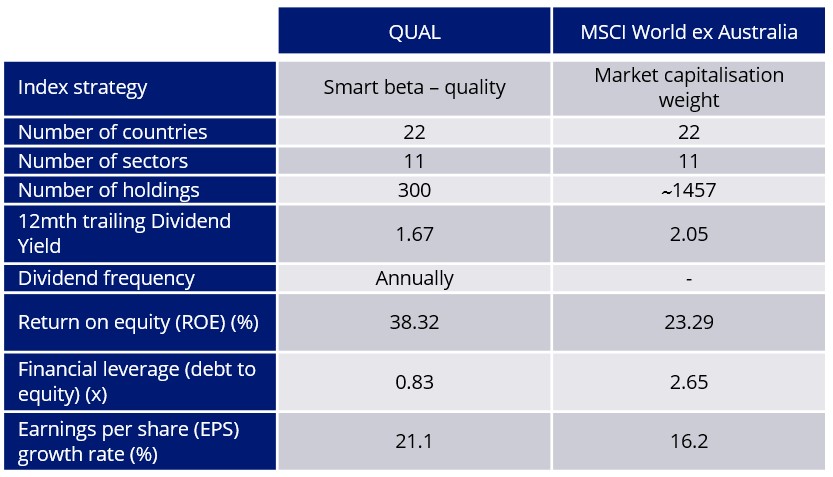
Source: VanEck, MSCI, FactSet, as at 16 September 2022. You cannot invest directly in an index.
As you would expect, QUAL has higher ROE, lower debt to equity and a higher EPS growth rate.
QUAL vs International Equity Index - Performance
Since QUAL launched in 2014, its quality approach has served Australian investors well. Over longer-term periods QUAL has outperformed the International Equity Index – testament to quality investing’s prowess across the range of economic cycles.
Chart 1: Cumulative performance since QUAL inception date
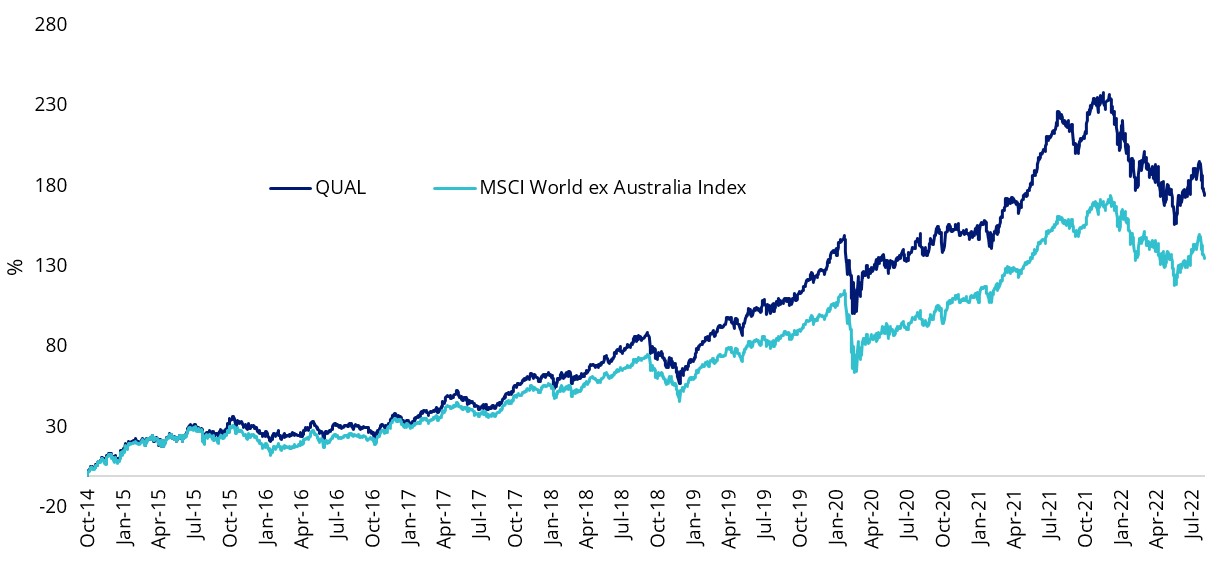
Table 2: Trailing performance

*Inception date is 29 October 2014 – the most recent factsheet is here.
Chart 1 and Table 2 source: Morningstar Direct, VanEck as at 31 August 2022. The chart and table above show past performance of QUAL and of the MSCI World ex Australia Index. You cannot invest directly in an index. Results are calculated to the last business day of the month and assume immediate reinvestment of distributions. QUAL results are net of management fees and other costs incurred in the fund, but before brokerage fees and bid/ask spreads incurred when investors buy/sell on the ASX. Returns for periods longer than one year are annualised. Past performance is not a reliable indicator of future performance. The MSCI World ex Australia Index (“MSCI World ex Aus”) is shown for comparison purposes, as it is the widely recognised benchmark used to measure the performance of developed market large- and mid-cap companies, weighted by market capitalisation. QUAL’s index measures the performance of 300 companies selected from MSCI World ex Aus based on MSCI quality scores, weighted by market cap x quality score at rebalance. Consequently, QUAL’s index has fewer companies and different country and industry allocations than MSCI World ex Aus. Click here for more details.
QUAL vs International Equity Index - Flight to quality
In investing circles there is a widely used saying ‘flight to quality’. What this means is that when risks are pronounced in markets investors choose quality versus non-quality assets to ride the storm. Historically, quality companies have lost less and recovered faster in risky periods associated with market falls. In the table below, we have highlighted key systemic crises: the dot-com bubble, GFC, European Sovereign debt crisis and the COVID-19 market meltdown. With the exception of the current stock market sell off, quality international investors lost less and in all of the stock market crises since 2000, quality companies recovered faster.
Table 3: Significant drawdowns, 2000 to 2022
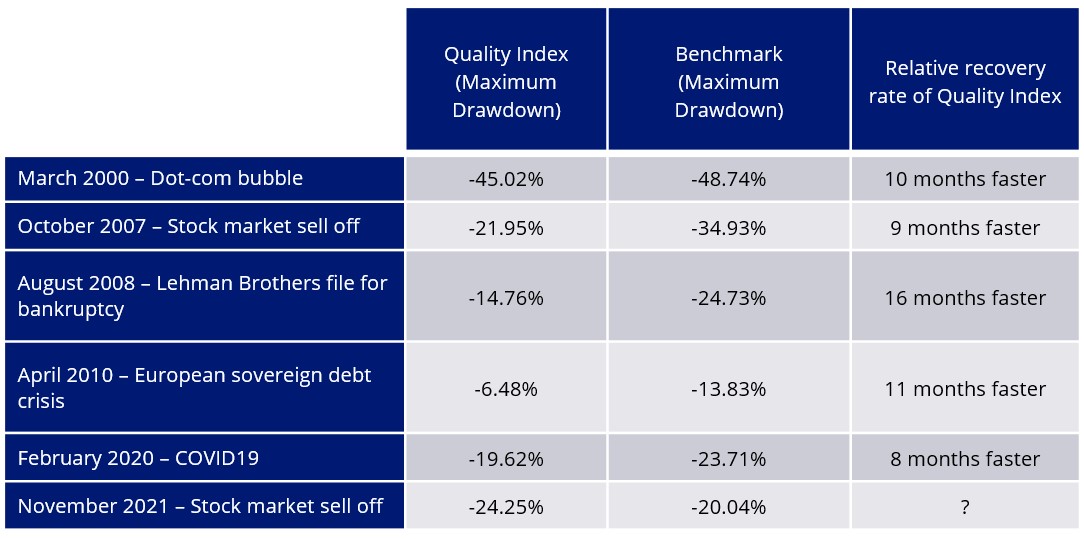
Source: MSCI, VanEck, Morningstar Direct. Comparison of drawdown between the MSCI World ex Australia Quality Index (‘Quality Index’) versus the MSCI World ex Australia Index (‘Benchmark’). Maximum drawdown is the peak to trough decline from the start of the month specified to the recovery date, expressed as a percentage. The rate of recovery is the number of periods taken to recover from the trough to peak incline. The calculations for the above include the reinvestment of all dividends but do not include fees and other costs associated with an investment in QUAL. You cannot invest in an index. Past performance is not a reliable indicator of future performance of the index or QUAL.
QUAL vs International Equity Index - Top 10 holdings
Below you can see the top 10 companies. The top 10 holdings are companies that investors can relate to in their day-to-day lives – to see all the holdings in QUAL and their weightings click here.
Table 4: Top holdings QUAL vs MSCI World ex Australia Index
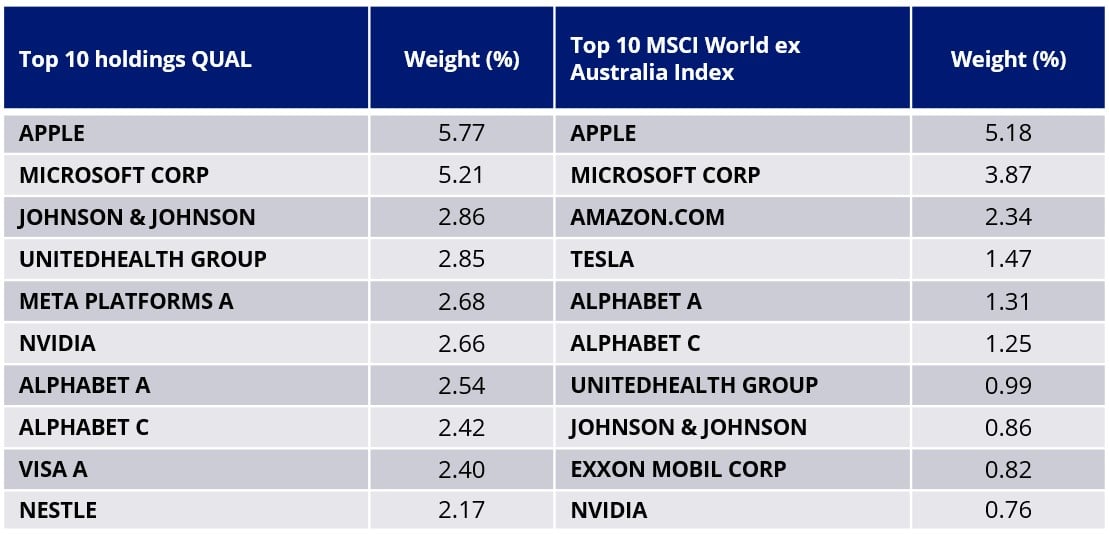
Source: FactSet, VanEck, MSCI, as at 31st August 2022.
QUAL vs International Equity Index - Style
When looking at portfolios it is important to determine what style, e.g. value or growth, and what size bias a portfolio holds, eg giant, large, mid or small. Below we can see QUAL’s. Importantly QUAL holds giant companies with a core-growth orientation relative to the International Equity Index.
Chart 2: QUAL holdings based style map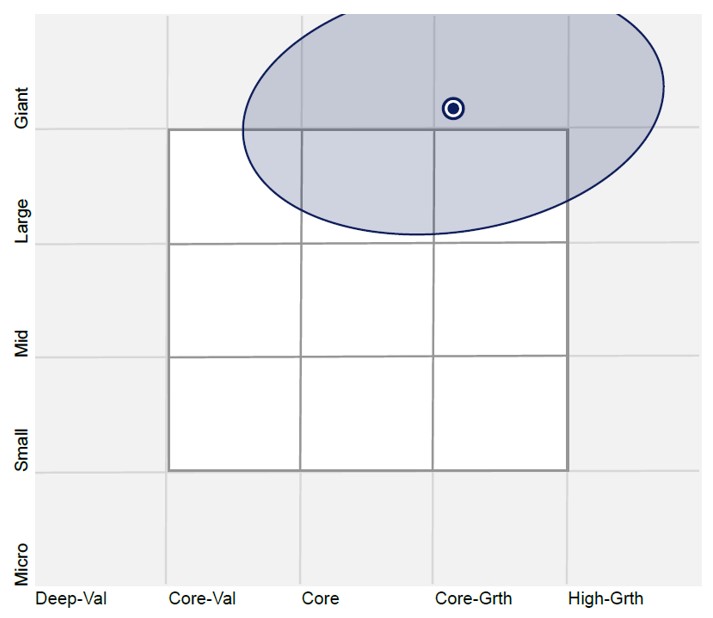
Source: Morningstar Direct, as at 31st August 2022.
Chart 3: MSCI World ex Australia Index holdings based style map
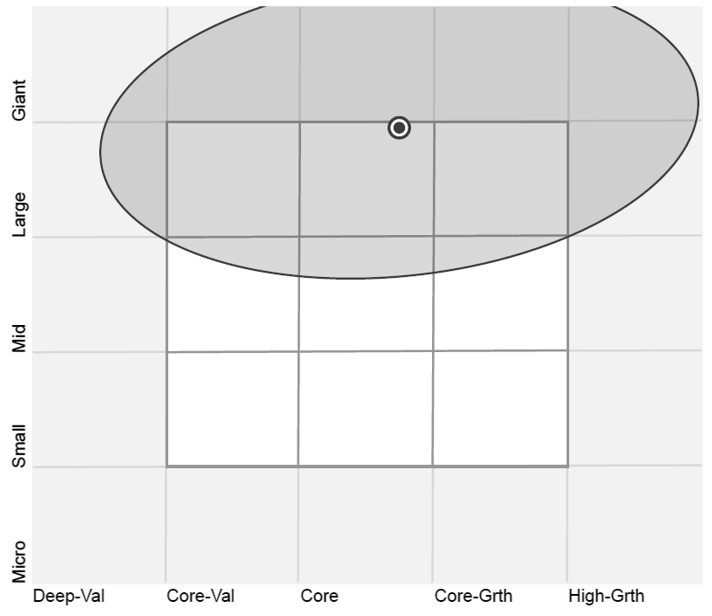
Source: Morningstar Direct, as at 31st August 2022.
While many international equity ETFs have merits for portfolio inclusion, you should assess all the risks and consider your investment objectives.
Hedged versions of many exposures noted exist too.
Past performance is no guarantee of future performance. The above is not a recommendation. Please speak to your financial adviser or stock broker.
For further information you can contact us at +61 2 8038 3300.
Key risks
An investment QUAL carries risks associated with: ASX trading time differences, financial markets generally, individual company management, industry sectors, foreign currency, country or sector concentration, political, regulatory and tax risks, fund operations and tracking an index. See the PDS for details.
Published: 21 September 2022
Any views expressed are opinions of the author at the time of writing and is not a recommendation to act.
VanEck Investments Limited (ACN 146 596 116 AFSL 416755) (VanEck) is the issuer and responsible entity of all VanEck exchange trades funds (Funds) listed on the ASX. This is general advice only and does not take into account any person’s financial objectives, situation or needs. The product disclosure statement (PDS) and the target market determination (TMD) for all Funds are available at vaneck.com.au. You should consider whether or not an investment in any Fund is appropriate for you. Investments in a Fund involve risks associated with financial markets. These risks vary depending on a Fund’s investment objective. Refer to the applicable PDS and TMD for more details on risks. Investment returns and capital are not guaranteed.




